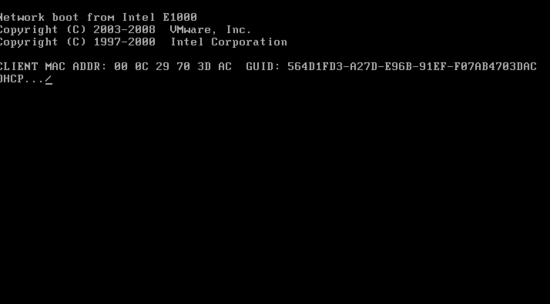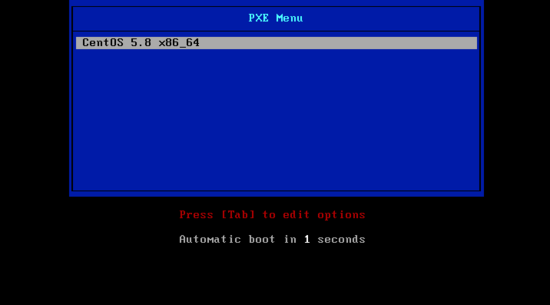| Updated 1 January 2020 | © 2020 Logiqwest, Inc. All rights reserved. |
 |
 |
TFTP Setup
The Quickstart server requires that a small boot images be initiated to the client server to be booted. This entails setting up a TFTP boot service and images. The follwing describes how to install and configure this service. Note that a basic DHCP server must have already been installed and configured. See Basic DHCP Server Setup.
Steps
- Install tftp-server (yum -y install tftp-server).
- Change 'disable' parameter to 'no' in the /etc/xinetd.d/tftp file.
- Create the TFTP directory layout for the PXE boot.
- Prerequisit: Mounted copy CentOS install or wget to to a web site to obtain vmlinuz and initrd.img.
- Copy vmlinuz and initrd.img to /tftpboot/images
- Create a default pxe configuration file in /tftpboot/pxelinux.cfg
- Open Firewall ports: 67:tcp, 68:tcp, 69:udp
tfpboot File Setup
| tftpboot/ | |||
| images/ | |||
| initrd.img | copied from os image | ||
| vmlinuz | copies from os image | ||
| pxelinux.cfg/ | |||
| default | new file created | ||
| menu.c32 | copies from /usr/lib/syslinux/ and edited | ||
| pxelinux.0 | copied from /usr/lib/syslinux/ |
Prerequisit
Use wget to obtain copies of vmlinuz and initrd.img for the linux version that is to be installed:
[root@kickstart ~]# wget http://mirror.stanford.edu/yum/pub/centos/5.9/os/x86_64/isolinux/vmlinuz [root@kickstart ~]# wget http://mirror.stanford.edu/yum/pub/centos/5.9/os/x86_64/isolinux/initrd.img
Install tftp Server
Perform yum to install the tftp Server software (e.g. yum -y install tftp-server):
[root@kickstart ~]# yum install tftp-server Loaded plugins: fastestmirror, security Loading mirror speeds from cached hostfile * base: mirror.hmc.edu * extras: mirrors.easynews.com * updates: mirror.5ninesolutions.com Setting up Install Process Resolving Dependencies --> Running transaction check ---> Package tftp-server.x86_64 0:0.49-2.el5.centos set to be updated --> Finished Dependency Resolution Dependencies Resolved ========================================================================================== Package Arch Version Repository Size ========================================================================================== Installing: tftp-server x86_64 0.49-2.el5.centos base 32 k Transaction Summary ========================================================================================== Install 1 Package(s) Upgrade 0 Package(s) Total download size: 32 k Is this ok [y/N]: y Downloading Packages: tftp-server-0.49-2.el5.centos.x86_64.rpm | 32 kB 00:00 Running rpm_check_debug Running Transaction Test Finished Transaction Test Transaction Test Succeeded Running Transaction Installing : tftp-server 1/1 Installed: tftp-server.x86_64 0:0.49-2.el5.centos Complete! [root@kickstart ~]#
Edit the tftp Configuration File
Edit /etc/xinetd.d/tftp and change the 'disable' parameter to 'no':
# default: off
# description: The tftp server serves files using the trivial file transfer \
# protocol. The tftp protocol is often used to boot diskless \
# workstations, download configuration files to network-aware printers, \
# and to start the installation process for some operating systems.
service tftp
{
socket_type = dgram
protocol = udp
wait = yes
user = root
server = /usr/sbin/in.tftpd
server_args = -s /tftpboot
disable = no
per_source = 11
cps = 100 2
flags = IPv4
}
Start the xinetd Service
Start the xinetd service with the service command (e.g service xinetd start)
[root@kickstart ~]# service xinetd start
Starting xinetd: [ OK ]
[root@kickstart ~]#
Install syslinux
Syslinux is a collection of boot loaders for the Linux operating system. Install this pacakge using yum (yum install syslinux):
[root@kickstart ~]# yum install syslinux Loaded plugins: fastestmirror, security Loading mirror speeds from cached hostfile * base: mirror.hmc.edu * extras: mirrors.easynews.com * updates: mirror.5ninesolutions.com Setting up Install Process Resolving Dependencies --> Running transaction check ---> Package syslinux.x86_64 0:3.11-7 set to be updated --> Finished Dependency Resolution Dependencies Resolved ========================================================================================== Package Arch Version Repository Size ========================================================================================== Installing: syslinux x86_64 3.11-7 base 474 k Transaction Summary ========================================================================================== Install 1 Package(s) Upgrade 0 Package(s) Total download size: 474 k Is this ok [y/N]: y Downloading Packages: syslinux-3.11-7.x86_64.rpm | 474 kB 00:01 Running rpm_check_debug Running Transaction Test Finished Transaction Test Transaction Test Succeeded Running Transaction Installing : syslinux 1/1 Installed: syslinux.x86_64 0:3.11-7 Complete! [root@kickstart ~]#
Create the TFTP Directory Layout
In the root directory, create the tftpboot directory and copy pxelinux software
[root@kickstart ~]# cd / [root@kickstart /]# mkdir -p /tftpboot/images [root@kickstart /]# mkdir -p /tftpboot/pxelinux.cfg [root@kickstart /]# cp /usr/share/syslinux/menu.c32 /tftpboot [root@kickstart /]# cp /usr/share/syslinux/pxelinux.0 /tftpboot [root@kickstart /]#
Prerequisit
Use wget to obtain copies of vmlinuz and initrd.img for the linux version that is to be installed:
(this is from a public site). You can get this from the OS ISO or from an internal OS install site.
[root@kickstart ~]# wget http://www.gtlib.gatech.edu/pub/centos/5.8/os/x86_64/isolinux/vmlinuz [root@kickstart ~]# wget http://www.gtlib.gatech.edu/pub/centos/5.8/os/x86_64/isolinux/initrd.img
Copy vmlinux and initrd.img
Copy vmlinuz and initrd.img to /tftpboot/images
[root@kickstart ~]# cp vmlinuz /tftpboot/images/ [root@kickstart ~]# cp initrd.img /tftpboot/images/ [root@kickstart ~]# ls -l /tftpboot/images/ total 14140 -rw-r--r-- 1 root root 12340659 Mar 23 19:56 initrd.img -rw-r--r-- 1 root root 2115772 Mar 23 19:56 vmlinuz [root@kickstart ~]#
Create Default PXE Configuration File
Create a default pxe configuration file in /tftpboot/pxelinux.cfg/ directory using a text editor
[root@kickstart ~]# vi /tftpboot/pxelinux.cfg/default
consisting of
## /tftpboot/pxelinux.cfg/default ## default menu.c32 prompt 0 timeout 10 MENU TITLE PXE Menu LABEL CentOS 5.8 x86_64 MENU LABEL CentOS 5.8 x86_64 KERNEL images/vmlinuz append initrd=images/initrd.img linux ks=http://192.168.201.1/OS_IMAGES/kickstart/test.cfg
NOTE: The 192.168.201.1 address assumes you are going to use the dhcpd/tftpboot server to contain the OS install file with a http server
Open Firewall Ports
Open Firewall ports 67, 68 and 69:
| Port | Type |
| 67 | tcp |
| 68 | tcp |
| 69 | udp |
Either use command line:
[root@kickstart ~]# vi /etc/sysconfig/iptables
# -A RH-Firewall-1-INPUT -m state --state NEW -m tcp -p tcp --dport 67 -j ACCEPT
# -A RH-Firewall-1-INPUT -m state --state NEW -m tcp -p tcp --dport 68 -j ACCEPT
# -A RH-Firewall-1-INPUT -m udp -p udp --dport 69 -j ACCEPT [root@kickstart ~]
# service iptables restart Flushing firewall rules: [ OK ]
Setting chains to policy ACCEPT: filter [ OK ]
Unloading iptables modules: [ OK ]
Applying iptables firewall rules: [ OK ]
Loading additional iptables modules: ip_conntrack_netbios_n[ OK ]
[root@kickstart ~]#
Or run the GUI (e.g. system-config-securitylevel)

Testing
Start up a new server and defined it to look for a pxe network boot. You should see the following screen followed by the PXE Menu that was defined.


Note:
- If you select the the menu you can start an install using the defined test.cfg kickstart file defined in the /tftpboot/pxelinux.cfg/default file. This kickstart file does not exist and will need to be create. See Enabling KickStart GUI's
- If you have installed the OS Image that is available to install (see Building an OS Image HTTP Server), the screen complaining about the missing kickstart file has a cancel option and will allow you to perform an interactive install the OS
